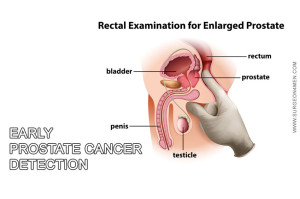Enlarged Prostate or Prostate Cancer?
Prostate gland is a gland situated at the start of the urethra and is a part of the male reproductive system. A normal prostate gland weighs around 20 to 30 grams and secretes the fluid which nourishes the sperms. It is believed that in almost all men above the age of fifty, there is some enlargement of the prostate gland. This enlargement leads to a condition called as benign prostate hypertrophy (BPH).
An enlarged prostate may or may not produce symptoms. Many people believe that an enlarged prostate may lead to prostate cancer. Therefore, they opt for surgical removal of the prostate gland even if it is not producing any symptoms. According to experts, no association has been found between enlarged prostate and prostate cancer. It is just a misconception which leads to many unnecessary surgeries. Benign prostate hypertrophy is a totally separate entity from prostate cancer. Patients of BPH may develop prostate cancer at some stage. But the presence of prostate enlargement does not in any manner increase the risk of prostate cancer.
Symptoms of Enlarged Prostate Gland
 Let us first find out why an enlarged prostate gland produces symptoms. Prostate gland is situated at the start of the urethra. When it enlarges, it presses upon the urinary bladder and the urethra. This, in turn, obstructs the normal flow of urine leading to symptoms of BPH. Some of the symptoms include:
Let us first find out why an enlarged prostate gland produces symptoms. Prostate gland is situated at the start of the urethra. When it enlarges, it presses upon the urinary bladder and the urethra. This, in turn, obstructs the normal flow of urine leading to symptoms of BPH. Some of the symptoms include:
- Increased frequency of micturition
- Increased urge of voiding urine
- Feeling of incomplete emptying of the bladder
- Inability to control the flow of urine
- Dribbling of urine
- Weak stream of urine
Cause of Enlargement of Prostate Gland
The exact reason behind BPH has not been found till date. However, ageing process definitely plays a role in the enlargement of the gland. Similarly, it is believed that testicular cells also have a role in increasing the size of the prostate gland. This belief is strengthened by the fact that if the testicles of a man suffering from BPH are removed, the prostate gland shrinks in size.
Diagnosis of Prostate Enlargement
An enlarged prostate gland can be felt while doing a digital rectal examination. Other tests to diagnose the severity of prostatic hypertrophy include:
 Measuring the rate of urine flow
Measuring the rate of urine flow- Measuring post-void residual urine in the bladder
- Measuring the pressure in the bladder
- Prostate Specific Antigen (PSA) measurement in blood. Increase in the level of this antigen may be an indicator of both BPH and prostate cancer.
- Cystoscopic examination of the bladder
Treatment of Prostate Enlargement
A prostate gland which is enlarged but does not produce any symptoms is best left as it is. However, if the symptoms are present and become worrisome, alpha-1 blocking agents are used to facilitate easy voiding of urine. Medicines like Finasteride and Dutasteride help in reducing the size of the prostate gland and improving the rate of flow of urine. However, if the symptoms are not controlled by these medicines, surgery becomes the treatment of choice. Trans-urethral resection of prostate (TURP) is the most commonly employed surgical technique. Here, the prostate gland is approached through the urethra and part of the gland which is pressing against the urethra and the bladder is removed.
Reference:
“Can an enlarged prostate turn into cancer?” by Cancer research UK. Accessed on April 28, 2015, retrieved from: http://www.cancerresearchuk.org/about-cancer/cancers-in-general/cancer-questions/can-an-enlarged-prostate-turn-into-cancer

